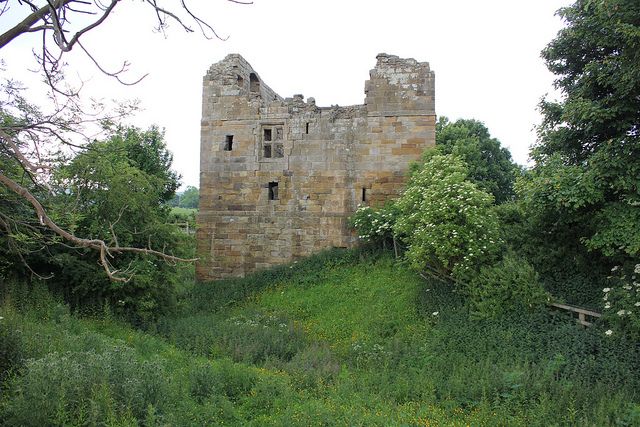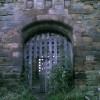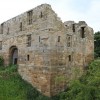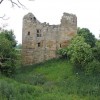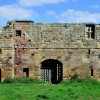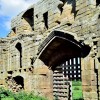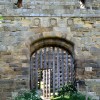Whorlton Castle Gatehouse and Moat
Uploader's Comments
Whorlton Castle, the stronghold of the Meynells, occupies a striking position at the end of the steep spur of the Cleveland Hills. The ground slopes on the north side to the Leven Valley, and the site is backed by the high summits which flank the entrance to Scugdale. The castle is of the 'motte and bailey' type, and its earthworks were probably thrown up not long after the Conquest. These earthworks cover 3 or 4 acres, and some outer works possibly inclosed the 'burgus' or town which usually grew up under a castle. Like other strongholds of this type, its buildings and defences were at first of wood. There is no evidence of the date at which masonry buildings took the place of those of timber, and very little is now left of the castle buildings except the gate-house. This building is a 14th-century rectangular structure of dressed stone, measuring externally 58 ft. by 33 ft., with a projecting vice at the north-west angle. It stands at the east end of the moated mound on which the castle was built, and faces north-east with the moat immediately below it on three sides. The outer walls are 7 ft. 6 in. thick, except on the inner side, where the width is reduced to 5 ft. 8 in., but all the internal walls and floors have gone. The end walls are now about 20 ft. in height above the level of the ground floor and the long side walls some 7 ft.or 8 ft. higher, but the ground falls rapidly from back to front, giving a greatly increased height to the building above the moat, the basement wall to the top of the plinth on either side of the entrance being 15 ft. in height. The plan followed the usual arrangement of vaulted passage-way through the middle of the building with a guard chamber on either side about 9 ft. high, and outer and inner portcullises, the grooves for which still remain. Above were two other floors the disposition of which can now only be conjectured. Externally the building is divided at about half its present height by a flat moulded string. Over the entrance are three shields with the arms of Meynell, Darcy and Greystock, and a fourth higher up between the windows of the upper floor charged with Meynell impaling Darcy. The entrance is 10 ft. wide with a segmental-headed arch of two orders 11 ft. high, the outer order rounded and the inner chamfered, the same detail being repeated on the inner entrance from the courtyard. The ground floor rooms are lighted by loops with wide internal splays at either end of the building and on either side of the entrance, with smaller ones towards the courtyard. There are fireplaces in the west wall and a small mural chamber in the south-west angle with garderobes in the end walls on each floor. The vaulting over the passage-way is said to have been standing till 1876; the springing of the ribs remains in the angles at a height of 9 ft. 6 in. above the present level of the floor. The wall ribs of the vaulting remain at the ends and have two hollow chamfered members. The loop holes facing the courtyard have trefoiled heads and inner pointed arches, but the heads of the others are simply pointed and the inner arches are segmental in shape. The loops to the room on the north side of the entrance have been widened. The vice is entered from the outside by a round-headed doorway, there being no access internally from the ground to the first floor. At the first-floor level there is a fireplace in each of the end walls, and L-shaped mural chambers 4 ft. wide lighted by loops in the external angles except at the northwest, where the vice is situated. On the east side are two tall square-headed windows of two lights with transom, the openings 3 ft. 6 in. wide, and the mullions flush with the face of the wall. There is also a similar window in each end wall. These mullioned openings form perhaps the most distinctive architectural feature on the outside of the building, and internally form deep recesses in the walls from which the garderobes and mural chambers are approached. At the south end of the west side a straight staircase in the thickness of the wall, lit by a loophole, gives access to the floor above, at which height the walls are reduced in thickness to 4 ft. 6 in. There is a passage-way the full length of the west wall lighted by a mullioned and transomed window similar to those on the front, and by two loopholes, with two doorways on the innerside. On the east are two other mullioned and transomed windows immediately above and similar to those below, between which are the slits for the chains of the drawbridge. The structure is in a more or less dilapidated state, and the entrance is now approached by a causeway across the moat.
Uploaded by Antony Cairns
on 9 July 2011
